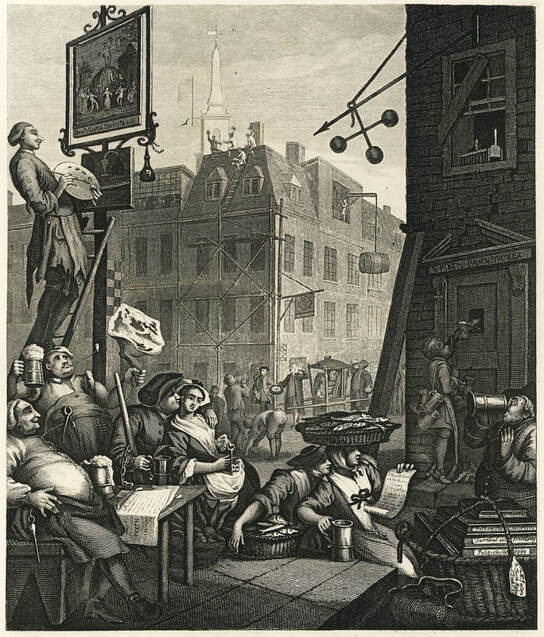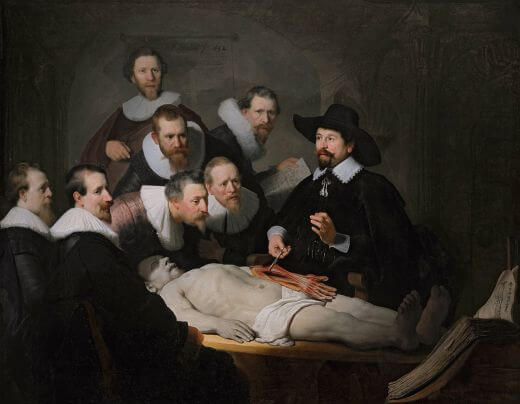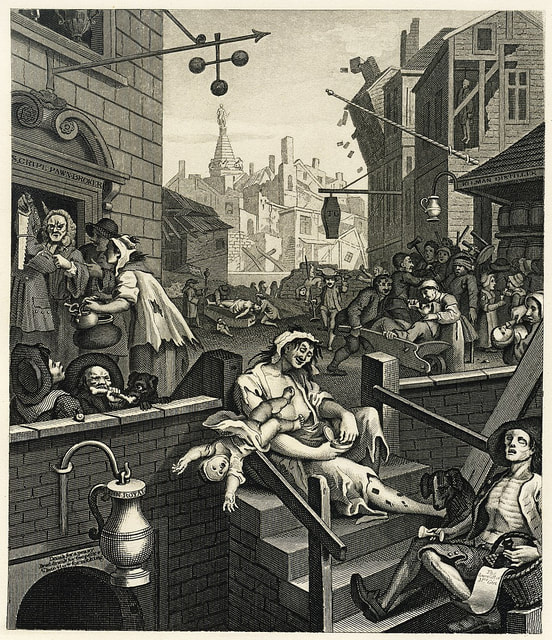|
Where? Room 1730 of the Main Floor of Tate Britain. Several other museums like the British Museum, Metropolitan Museum of Art, and National Gallery of Art also own this work but do not have it on permanent display.
When? 1751 What do you see? Several groups of well-fed people engage in a variety of activities while drinking mugs of beer. It is the birthday of King George II, and that asks for a celebration. On the left, two corpulent men hold big mugs of beer and one of them holds a huge leg of beef in his left hand. In front of them sits a man holding a beer while sharing a romantic moment with a woman. To the right of them, a couple of women with overflowing baskets of fish pause while enjoying a beer. To their right, a young boy with mugs hanging on a rope slung over his back goes around selling mugs of beer. He stops at the pawnbroker to hand him a beer through the peek hole. The pawn shop is in some state of disrepair as people do not need to pawn off their belonging in this prosperous world where people drink beer. The other buildings are well-maintained, and the church steeple on the top is a sign that people behave morally in this world full of beer. On the bottom right, a portly man enjoys his beer next to a pile of books in a basket. On the left, a painter in ragged clothes blissfully paints a cheery picture of men and women dancing around a mountain of barley. On top of the roofs, construction workers take a break drinking to celebrate while another barrel of beer is being lifted up. Finally, in the center, a wealthy woman in a sedan chair waits as her chairmen have temporarily put her chair down to drink a beer. Laborers around them drink their beer while continuing their work in a timely manner. Backstory: Beer Street takes place during a major movement in 18th-century England: The Age of Enlightenment. This was a philosophical and intellectual movement where people began to ponder major scientific and philosophical thoughts that were captured in paintings such as The Anatomy Lesson of Dr. Nicolaes Tulp by Rembrandt. These ideas were published, and many people learned from them and developed them further. Another idea behind the Age of Enlightenment is that people were trying to apply these new ideas to help other people. Before the Gin Craze, French brandy was popular and fashionable, however, during the Second Hundred Years’ War between France and England, French products were considered unpatriotic and soon lost their following. This led to the Gin Craze where gin and other cheap spirits quickly became popular, and overconsumption of these drinks caused many problems among the lower-class people. William Hogarth’s print was, in essence, a piece of propaganda in favor of the British beer market. Similar to the popularity of Coca-Cola in the United States during modern times, Hogarth makes the argument that beer was not only a remedy to the unregulated gin trade but also a drink that is truly British and helps the country.
Gin Lane: At the time Hogarth created Beer Street, he also created a companion piece called Gin Lane. Most museums that own Beer Street, also have a print from Gin Lane as they were created together. Museums owning Gin Lane include Tate Britain, the British Museum and the National Gallery of Art. However, most museums do not have the prints on permanent display as they are light sensitive. The original copperplates for both works are owned by the Metropolitan Museum of Art.
Gin Lane shows the perilous effects that excessive gin consumption can have on your life. It shows the opposite side of Beer Street where drinking gin leads to chaos, negligence, street brawls, and poverty. The only ones benefiting from the gin craze are the distillery, the pawn shop, and the undertaker.
Who is Hogarth? William Hogarth was born in 1697 in London where he would die 66 years later. Hogarth carefully examined life in 18th-century London and detailed it in etchings and painted satires. He included many symbolic features in his works such that his pieces are not only entertaining but also contain several moral messages.
Hogarth created art both for the upper and lower class. He painted works for his richer clients but also created etchings and engravings of his works that could be mass-produced and sold at a lower price to a larger audience. Among his works is a series of satirical works about the British upper class. The first painting of that series is Marriage A-la-Mode: 1, The Marriage Settlement in the National Gallery in London.
Written by Caylee Fletcher
References:
0 Comments
Leave a Reply. |
Categories
All
|
- Home
- Blog
-
Museums
- Alte Pinakothek
- Art Institute of Chicago
- Baltimore Museum of Art
- Barber Institute of Fine Arts
- Bargello
- Barnes Foundation
- British Museum
- Church of Sant’Anastasia
- Cleveland Museum of Art
- Courtauld Institute of Art
- Detroit Institute of Arts
- Frans Hals Museum
- Galleria Borghese
- Gallerie dell'Accademia
- Getty Museum
- Guggenheim
- Hermitage Museum
- Kunsthistorisches Museum
- Kunstmuseum Basel
- Legion of Honor Museum
- Louvre
- Mauritshuis
- Metropolitan Museum of Art
- Musee d’Orsay
- Museum of Fine Arts in Boston
- Museum of Modern Art
- National Gallery in London
- National Gallery of Art
- National Museum in Poznań
- Norton Simon Museum
- Ny Carlsberg Glyptotek
- Palace of Versailles
- Palazzo Pitti
- Palazzo Vecchio
- Petit Palais
- Philadelphia Museum of Art
- Prado
- Pushkin Museum
- Ravenna Art Museum
- Rijksmuseum
- San Diego Museum of Art
- Santa Maria delle Grazie
- St. Peter's Basilica
- Städel Museum
- Statens Museum for Kunst
- Tate Britain
- Tate Modern
- Timken Museum of Art
- Uffizi
- Vatican Museums
- Wallace Collection
-
Artists
- Altdorfer
- Anguissola
- Berlin Painter
- Bosch
- Botticelli
- Boucher
- Bronzino
- Bruegel the Elder
- Brunelleschi
- Cabanel
- Caillebotte
- Canova
- Caravaggio
- Carpeaux
- Cezanne
- Cimabue
- David
- Degas
- Delacroix
- De Maria
- Donatello
- El Greco
- Fontana
- Fra Angelico
- Fragonard
- Gauguin
- Gentileschi
- Gericault
- Gonzalez-Torres
- Goya
- Hals
- Hogarth
- Hokusai
- Ingres
- Leonardo da Vinci
- Lippi, Filippo
- Longhi, Barbara
- Lorrain
- Makovsky
- Manet
- Massys
- Matisse
- Merian
- Michelangelo
- Mochi
- Modigliani
- Monet
- Panini
- Parmigianino
- Perugino
- Picasso
- Pisanello
- Raphael
- Rembrandt
- Renoir
- Reynolds
- Rivera
- Rodin
- Rubens
- Scultori
- Seurat
- Steen
- Tintoretto
- Titian
- Toulouse-Lautrec
- Turner
- Uccello
- Van der Weyden
- Van Dyck
- Van Eyck
- Van Gogh
- Van Hemessen
- Vasari
- Velazquez
- Vermeer
- Veronese
- Vigée Le Brun
-
Locations
- Books
- About Us





